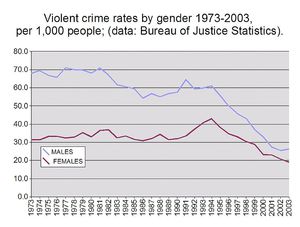Gender and Crime
Differences Between Male And Female Offending Patterns

Females have lower arrest rates than males for virtually all crime categories except prostitution. This is true in all countries for which data are available. It is true for all racial and ethnic groups, and for every historical period. In the United States, women constitute less than 20 percent of arrests for most crime categories.
Females have even lower representation than males do in serious crime categories. Since the 1960s in the United States, the extent of female arrests has generally been less than 15 percent for homicide and aggravated assault, and less than 10 percent for the serious property crimes of burglary and robbery.
Aside from prostitution, female representation has been greatest for minor property crimes such as larceny-theft, fraud, forgery, and embezzlement. Female arrests for these crime categories has been as high as 30 to 40 percent, especially since the mid-1970s. The thefts and frauds committed by women typically involve shoplifting (larceny-theft), "bad checks" (forgery or fraud), and welfare and credit fraud—all compatible with traditional female consumer/domestic roles.
Trends in female crime relative to male crime are more complex. Some writers claim that female crime has been increasing faster than male crime, as measured by the percentage of female arrests. This has clearly been true in the case of minor property crimes, where the percentage of female arrests had about doubled between 1960 and 1975 (from around 15 to 30 percent or more), with slight additional increases since then. Smaller but fairly consistent increases are also found for substance abuse categories, but they remain less than 20 percent for all categories. The same can be said of major property crimes (which remain less than 10 to 15%). However, the percentage of female arrests has declined for other categories like homicide and prostitution; and it has fluctuated for still other categories such as aggravated assault and druglaw violations (see Steffensmeier, 1993, for a review of trends and explanations).
The patterns just described are corroborated by other sources of data. The National Crime Victimization Survey asks victims about the gender of offenders in crimes where the offender is seen. The percentage of female offenders reported by victims is very similar to (or lower than) the female percentage of arrests for comparable categories. Self-report studies also confirm the UCR patterns of relatively low female involvement in serious offenses and greater involvement in the less serious categories.
From a variety of sources, it is clear that females are less involved in serious offense categories, and they commit less harm. Women's acts of violence, compared to those of men, result in fewer injuries and less serious injuries. Their property crimes usually involve less monetary loss or less property damage.
Females are less likely than males to become repeat offenders. Long-term careers in crime are very rare among women. Some pursue relatively brief careers (in relation to male criminal careers) in prostitution, drug offenses, or minor property crimes like shoplifting or check forging.
Female offenders, more often than males, operate solo. When women do become involved with others in offenses, the group is likely to be small and relatively nonpermanent. Furthermore, women in group operations are generally accomplices to males (see Steffensmeier, 1983, for a review). And males are overwhelmingly dominant in the more organized and highly lucrative crimes, whether based in the underworld or the "upperworld."
Females are far less likely than males to become involved in delinquent gangs. This distinction is consistent with the tendency for females to operate alone and for males to dominate gangs and criminal subcultures. At the onset of the twenty-first century, female gang involvement was described as a sort of "auxiliary" to a male gang. By the 1980s and 1990s, gang studies found somewhat increased involvement on the part of girls (perhaps 15%), including some allfemale gangs. Regardless, female gang violence has remained far less common than male gang violence.
The criminal justice system's greater "leniency" and "chivalry" toward females may explain a portion of the lower official offending rates of women in comparison to men. Likewise, the justice system's tendency to be relatively less lenient and chivalrous toward females today may help explain recent increases in levels of female arrests. Although there appear to be relatively small differences between adult women and men in likelihood of arrest or conviction, women defendants do appear to have a lower probability of being jailed or imprisoned. This difference appears to be related to a variety of factors: pregnancy, responsibilities for small children, the greater likelihood to demonstrate remorse, as well as perceptions that women are less dangerous and more amenable to rehabilitation (Daly; Steffensmeier, Ulmer, and Kramer).
Additional topics
- Gender and Crime - Explaining Female Offending
- Gender and Crime - Similarities In Male And Female Offending Rates And Patterns
- Other Free Encyclopedias
Law Library - American Law and Legal InformationCrime and Criminal LawGender and Crime - Similarities In Male And Female Offending Rates And Patterns, Differences Between Male And Female Offending Patterns